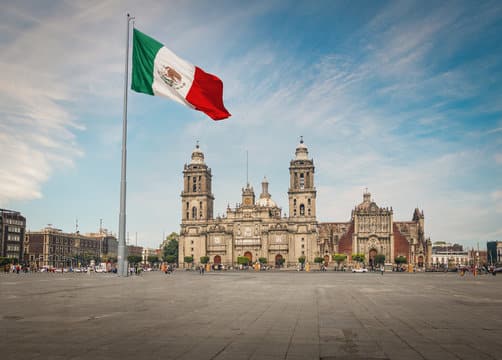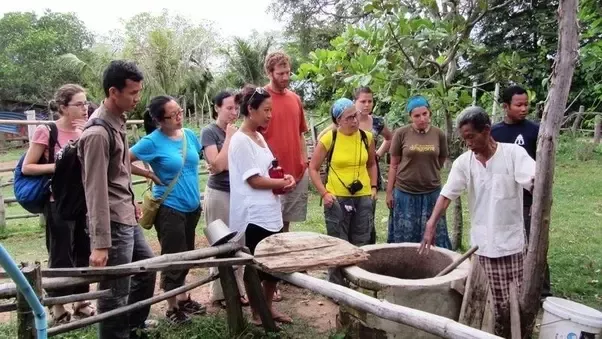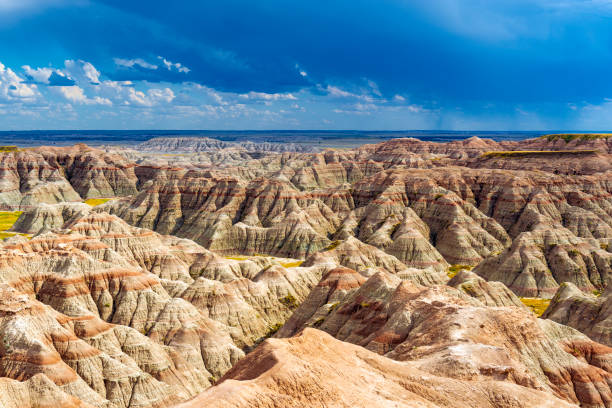
Badlands National Park is a stunning natural national park situated within the White Rider region of the United States in South Western South Dakota. Known for its unique geological formations holding world’s largest “fossil beds” collections.
Park spans over 2, 42,756 acres of the land, witnessing eroded buttes and pinnacles with vast collections of undisturbed mixed grass prairie. Fossil Beds belonging to Badlands National park are around 75 to 28 million years old. Despite its fossil beds and unique geological formations, the park is a perfect place to spot diverse flora and fauna like bison, bighorn sheep, back footed ferrets and prairie dogs.
Related Article: Yellowstone National Park.
Badlands National Park History
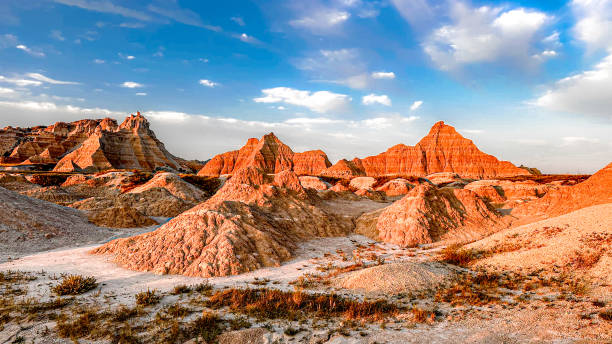
Badlands National Park was officially established in 1978, but its history dates back to 12,000 years ago. Place includes significant historical values which was once home of Lakota Sioux indigenous peoples land. Initially Badlands National Park was Inland sea, but over a period of time due to the erosion and sedimentation filled to this sea over millions of years. Once the place was suitable for living then indigenous people settled there till the European settlers arrived.
Archaeologists found early sites belonging to a culture known as “Planis Archaic” which are recent sites belonging to Arikara and Oglala Lakota tribe’s sites. However, studies also explain that the region gives insights to life of 33 million years ago. Place witnessed the world’s largest collection of mixed grass prairie, Oligocene fossil resources and remnants of sea and turtle shells.

During the early 1800s, first European explorers began to come to the park and started documenting the region’s unique landscapes. During their research the place got a name called “Badlands” due to its unique topographic and geological formations, challenging terrains and steep routes to hike for settlers and backpackers. After the finish their research Badlands National Park got global recognition as well as the region gained global attention for its striking beauty and unique fossil beds.
Over a period of time, more number of western prairie comes to Badlands National Park to live with other indigenous prairie dogs, bald eagles, antelope and wild bison. Initially the park was part of the Buffalo Gap National Grassland, before officially designated as Badland National Park in 2003.
Despite breath-taking landscapes, Today, Badlands National park is blessed by fossils from ancient mammals and paleontological resources. However the region offers a good number of insights of prehistoric environments, landscapes, wildfires and outdoor activities.
Badlands National Park Size
Badlands National Park spans over 2, 42,756 acres of the land or 379.3 sq. mi. including largest collections of fossil beds and undistributed mixed grass prairie and pinnacles, eroded buttes and wildlife’s.
Badlands National Park Animals
There are a good number of animals available to see and explore, and each of them are unique in its nature and most of them migrated to Badlands National Park from different locations of the world.
1. American Bison

Native to the American Bison or Buffalo, especially reintroduced after the species suffered devastating losses in the late 19th century. Badlands National Park presently holds around 1,200 bison and out of this most of them are recently born bison. Interesting fact is Native American coalition dedicated to preserving traditional buffalo practices. Visitors can spot Bison year round in order to maintain 200 feet distance while watching.
2. Black Footed Ferret
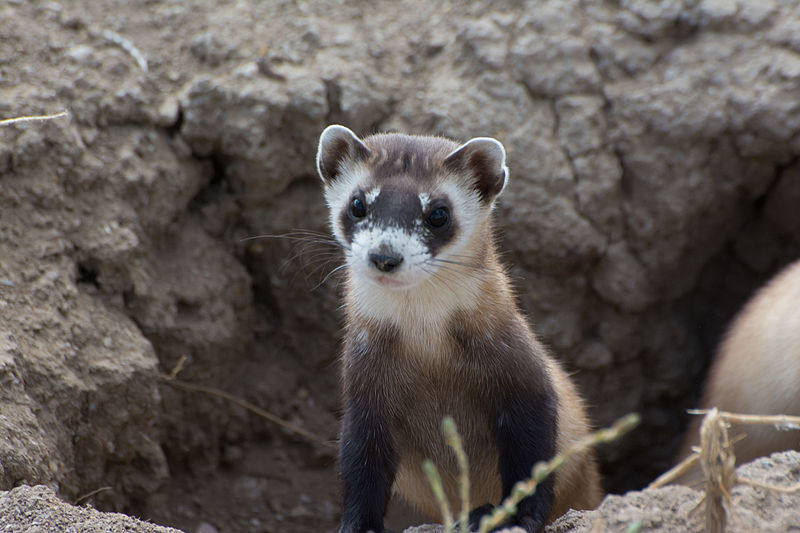
From 1996 to 1999 a total of 147 Black Footed Ferrets were introduced in the Conata Basin area of Badlands National Park. Black Footed Ferret is considered as one of the only self-sustaining black footed ferret populations in the world. Every year nature conservancy estimates monitors and spotlights for ferrets yearly, keeping an eye on its health. Presently only 120 Black Footed Ferrets live under the park and it is considered as the most sustainable animal in the world.
3. Bighorn Sheep
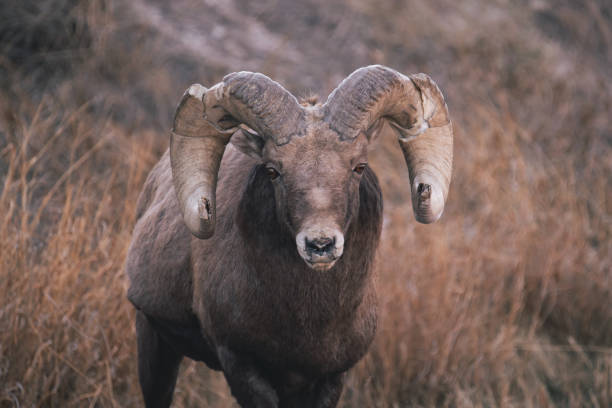
Known for rarest and most endangered animals in the world, Bighorn Sheep migrate to Badlands Park from Serbia. Belongs to grazers category usually consumes grasses and shrubs. It has a unique body structure, especially its stomach. Which has a complex four chambered stomach that helps to get sufficient nutrients to the body even during dry or humid conditions. Currently there are no natural adult sheep available in Badlands National Park, most of them died due to accidents and diseases.
4. Prairie Dogs
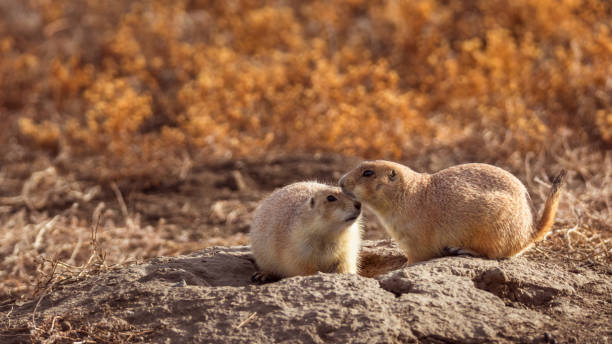
Prairie Dogs belong to the SciurIdae family, a type of forest Squirrel. These Prairie Dogs belong to the squirrels and chipmunks members, with the physical size of 14 to 17 inches in length and 1 to 3 pounds of weight. Badlands National Park is home to Prairie dogs like coyotes, bobcats, badgers, foxes, rattlesnakes and birds of prey. Most of the Prairie Dogs belong to the North American natives, also known as one of the most endangered species in North America.
5. Birds of Prey
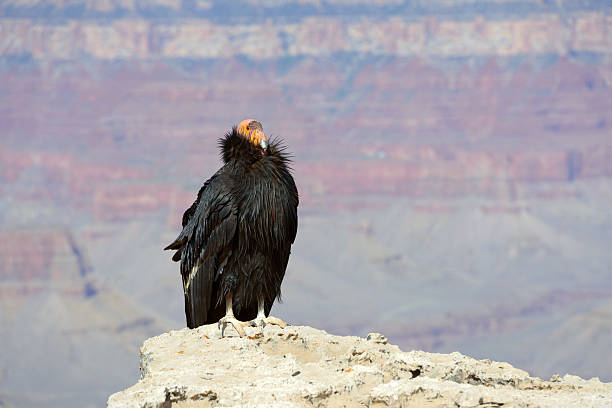
Birds of Prey has 4 traits in common like hooked beaks, sharp talons, good eyesight and carnivorous diet. Its body features such as beaks, talons and sharp eyesight make it perfect for its hunting. Bird of Prey includes scaly talons, white tale. Mule fawns, pronghorn, hooked beaks designed to catch fishes and ripping flesh.
Bird of Prey is so unique in nature, its color and patterns are not like other birds or eagles. It has different morphs and appears visually in different colours here. Badland National Park includes a number of small rodents of prey, which includes prairie dogs, rabbits, black footed ferrets and squirrels and insects.
6. Other Animals

Despite major animals, Badlands National Park is also blessed by some other small animals like mammals and birds. Like Amphibians, Pronghorn, Butterflies, Reptiles and Prairie Rattlesnakes. Rattlesnakes are unique mammals which can grow up to 5 feet long, have a triangular head and body covered in dark blotches.
Reptiles live in cold winter areas, only 9 species available in the park. These turtles include snakes, and lizards which live in temperatures of over 100 degrees in summer and -20 F in winter.
Kruger National Park, South Africa.
Top 10 Interesting Facts about Badlands National Park
Badlands National Park includes some of the unknown and mysterious facts, which most of the visitors or backpackers might not know. Let’s see;
- Once it was an Inland Sea. Around 80 million years ago, Badlands region was filled by the Inland Sea (Late Cretaceous Epoch), after 75 million years ago, sediments of sand, clay and slit filled the sea transformed into massive fossil beds.
- Name Badlands came from the Lakota, which means “Land that is bad”. Due to its humid conditions, bizarre topography and extreme temperature, the place is called a “Badlands”.
- Home to some of the world’s most endangered species. Badlands is home to many resilience creatures such as American Bison, Bighorn Sheep, Prairie Dogs and Birds of Prey even in North America too.
- Badlands National Park once purchased by France. Yes, during the 18th century the majority of the park was controlled by France like the Missouri valley. As per the 1763 Treaty of Paris, the United States purchased from France for a war penalty of $11,250,000.
- Badlands holds the world’s biggest collection of Fossil Beds. These Fossil beds help travellers see nature trails and the weird topography of the park. Collections of the fossils are illegal.
- Peter Norbeck helped to make a normal natural region into Badlands National Park. He was a legislator of South Dakota who pushed many development and conservative programs to make national parks along with many other public lands.
- Badlands comes under the ecological area called “mixed grass prairie”. Considered as the largest undisturbed area are tall grass prairies to the east and short grass to the west.
- Region used as a practice place for bombing ranges during World War II. Portions of Pine Ridge Reservation was seized by the Department of the Army for practice of bombing range.
- Badlands National Park is a region called “The Pine Ridge Indian Reservation” governed by the Oglala Sioux Tribes.
- Native American once used it for hunting grounds. First endangered tribes known hunters were the “Paleo-Indians” and “Arikara”, who used the land to hunt animals and live in these areas.
Badlands National Park Tickets
All visitors who willing to explore the unique beauty of this national park they must comply any one of the below entrance passes;
1. Standard Pass: $ 15.00 to $ 30.00
2. Annual Pass: $ 55.00
3. American Beautiful Pass (Including Senior Pass): Free to $ 80.
Remember Entrance Fees or Ticket Price is subject to change, so it is very important to visitors to check in prior before going to the national park at its official websites.
Best Time to Visit Badlands National Park
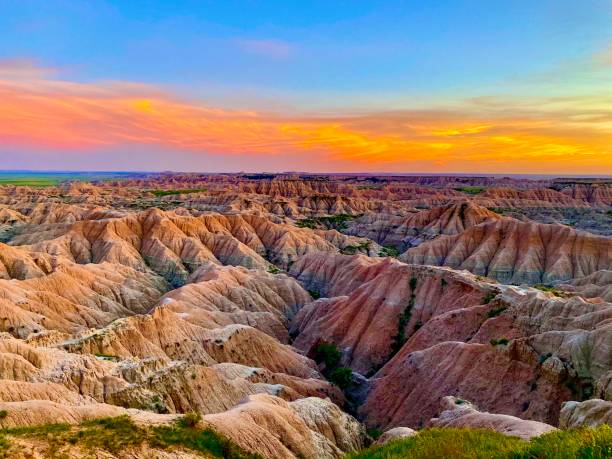
If you want to explore the beauty of the park, you should probably be there from April and May or from September to October. During these periods temperatures are mild and the park is generally uncrowded.
Winter offers a different experience to backpackers than the summer. During winter Badlands often experience snow falls and blankets while temperature ranges from the low teens to the high 30 degree Celsius.
Related Articles: Zion National Park
Q: How Big is Badlands National Park?
A: Badlands National Park is spans 2, 42,756 acres or 98,743 hectares of the land coverages. Park includes flora and fauna and mixed grass prairies.
Q: What city is Badlands National Park in?
A: It situated in Rapid city of South Dakota State of United States. Park located just 75 miles away from the Rapid city.
Q: When was the Badlands National Park Established?
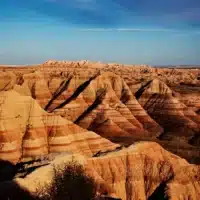
A: Initially The South Dakota Legislature decided to take a petitioned to build the township of Badlands as a National Park. But officially established as a national park in 1978.

